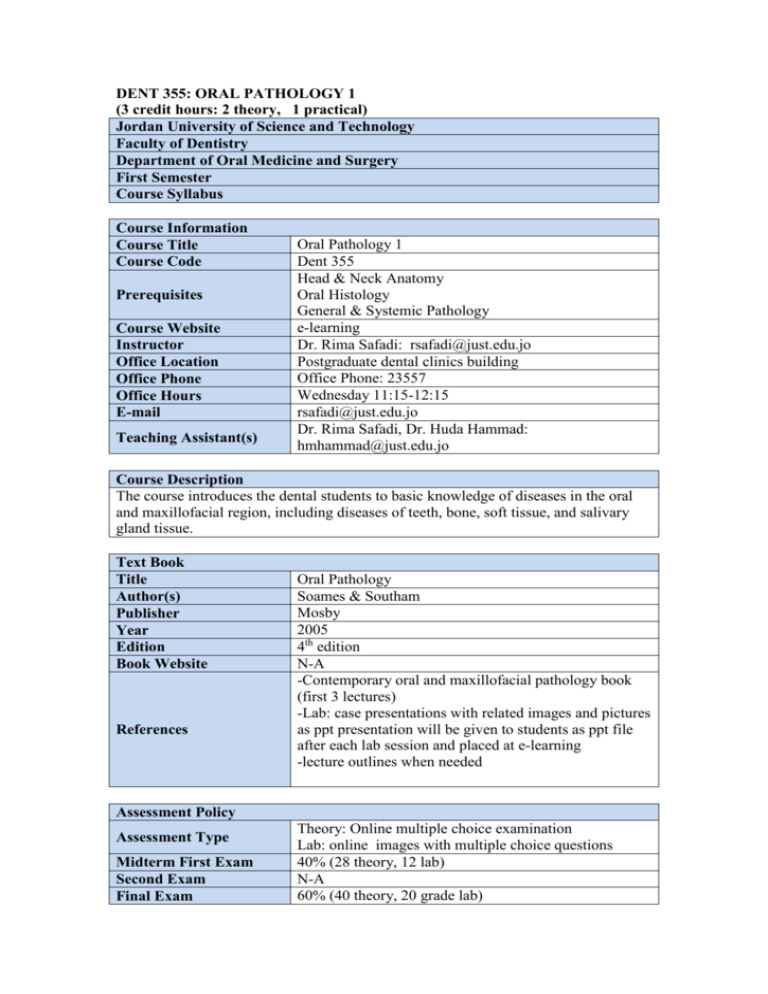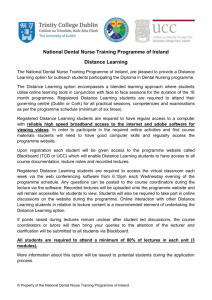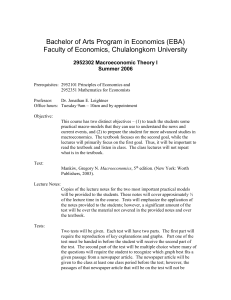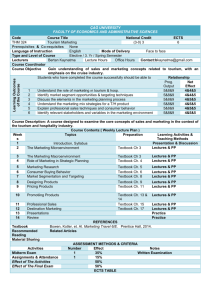oral pathology 1 - Jordan University of Science and Technology
advertisement

DENT 355: ORAL PATHOLOGY 1 (3 credit hours: 2 theory, 1 practical) Jordan University of Science and Technology Faculty of Dentistry Department of Oral Medicine and Surgery First Semester Course Syllabus Course Information Course Title Course Code Prerequisites Course Website Instructor Office Location Office Phone Office Hours E-mail Teaching Assistant(s) Oral Pathology 1 Dent 355 Head & Neck Anatomy Oral Histology General & Systemic Pathology e-learning Dr. Rima Safadi: rsafadi@just.edu.jo Postgraduate dental clinics building Office Phone: 23557 Wednesday 11:15-12:15 rsafadi@just.edu.jo Dr. Rima Safadi, Dr. Huda Hammad: hmhammad@just.edu.jo Course Description The course introduces the dental students to basic knowledge of diseases in the oral and maxillofacial region, including diseases of teeth, bone, soft tissue, and salivary gland tissue. Text Book Title Author(s) Publisher Year Edition Book Website References Oral Pathology Soames & Southam Mosby 2005 4th edition N-A -Contemporary oral and maxillofacial pathology book (first 3 lectures) -Lab: case presentations with related images and pictures as ppt presentation will be given to students as ppt file after each lab session and placed at e-learning -lecture outlines when needed Assessment Policy Assessment Type Midterm First Exam Second Exam Final Exam Theory: Online multiple choice examination Lab: online images with multiple choice questions 40% (28 theory, 12 lab) N-A 60% (40 theory, 20 grade lab) Assignments Attendance Participation N-A N-A N-A Course Objectives To acquire a basic understanding of clinical, histopathological and radiographic presentation when appropriate of the main oral and maxillofacial diseases in the following topics: 1. Disorders of development of teeth, bone and soft tissues 2. Other disorders of teeth. 3. Disorders of the dental pulp 4. Periapical periodontitis. 5. Cysts of the jaws and oral soft tissues. 6. Connective tissues hyperplasia, neoplasia, and related disorders. 7. Keratoses and related disorders of the oral mucosa. 8. Oral epithelial tumors and melanocytic lesions 9. To acquire the skills of providing a reasonable differential diagnosis for cases presented in lab sessions. Weights 18.7% 6.25% 6.25% 6.25% 18.7% 12.5% 12.5% 18.7% Teaching & Learning Methods Classroom lectures as power point presentation using a computer, data show and screen. Labs: Class case-discussions on clinical, radiographical and histopathological images of clinical cases aiming at providing scientific differential diagnosis in lab/practical sessions. Students are encouraged during lab sessions to describe the findings in the provided images, give a differential or definitive diagnosis and defend it. This way, students are encouraged to study the material given in previous lectures and be ready for lab discussions. Tests and exams, Review of exams Textbook reading assignments Learning Outcomes: Upon successful completion of this course, students will be able to Related Reference Objective(s) Understand and diagnose various Lectures 1-3: 1st developmental disorders affecting oral chapter in second 1, 9 and maxillofacial region reference -1st lab images/clinical cases handed in class Understand the clinical features of teeth Lectures 4-6 Chapter disorders other than caries, understand 3,4,5 in text book 2, 3, 4, 9 the clinical, radiographic and -2nd lab images/clinical histopathological features of pulp and cases handed in class periapical inflammatory conditions Classify jaw cysts and understand their pathogenesis, clinical, radiographic and histopathological features. Be able to perform a differential diagnosis of jaw cysts Understand the most common connective tissue hyperplasias of the oral cavity and most common neoplasms. Perform a differential diagnosis of an exophytic lesion Understand the definitions, pathogenesis, clinical and histopathologic presentations of keratosis and related disorders of oral mucosa Understand the definitions, pathogenesis, clinical and histopathologic presentations of oral epithelial tumors, melanocytic nevi and malignant melanoma as well as the epidemiology/etiology of oral cancer 5, 9 6, 9 7, 9 8, 9 Lectures 7-9-Chapter 6 in text book -3rd lab images/clinical cases handed in class Lectures 10-11-Chapter 8 in textbook -4th lab images /clinical cases handed in class Lectures 12-13-chapter 9 in textbook -5th lab images /clinical cases handed in class Lectures 14-16 Chapter 10 in textbook -6th lab images /clinical cases handed in class Useful Resources • Oral and maxillofacial Pathology by Neville et al, Saunders, 2nd edition 2002, • Useful websites: http://www.dental.mu.edu/oralpath/opgloss.html http://www.usc.edu/hsc/dental/opath/ http://www.forsyth.org/oralpathology/ http://www.library.vcu.edu/tml/oralpathology/ http://www.mednet.gr/pim/oralpath.htm http://www.uiowa.edu/~oprm/AtlasWIN/AtlasFrame.html http://aaomp.org/ http://abomp.org/links.htm http://www.lib.uiowa.edu/hardin/md/dent.html http://www.usc.edu/hsc/dental/opfs/index.html http://www.mic.ki.se/MEDIMAGES.html#DentistryandOralHealth Course Content Week Topics 1 3,4, Introduction to the course Disorders of development of teeth, soft tissues and bone 3 lectures, 1 lab Non-carious disorders of teeth, 1 lecture Disorders of the dental pulp, 1 lecture 4, 5 Periapical periodontitis, 1 lecture and 1 lab 1,2,3 3 Chapter in text NA 1st in second reference 3rd in textbook 4rd in textbook 5rd in textbook 6, 7 8 9,10 11, 12 13, 14 Cysts of the jaws and oral soft tissues 3 lectures, 1 lab Midterm exam week Connective tissues hyperplasia, neoplasia, and related disorders 2 lectures, 1 lab and a holiday Keratoses and related disorders of the oral mucosa 2 lectures, 1lab, and a holiday Oral epithelial tumors and melanocytic lesion 3 lectures, 1 lab 6rd in textbook 8rd in textbook 9rd in textbook 10rd in textbook Additional Notes Attendance: Students must attend not less than 90% of all scheduled classes and labs. Class participation is required. Should an absence be necessary, student should contact the course instructor within 1 week. Additional Notes Professionalism Gross violations of the formal codes are governed by University laws, which delineate the procedures to determine whether a violation of the code of ethics occurred and, if so, what remedies should be imposed. We encourage students to abide with the more sensitive approach to this by allowing the practice of a high Morality (or proper behavior), which defines right and wrong by the society, philosophy, religion, and individual conscience. Students and their instructors often make ethical choices reflexively/ But ethically sensitive situations, where time, emotions and marks are pressured, it becomes all too easy to be blind-sided by temptation/ The best antidote to ethical lapses is to commit in advance to a set of ethical principles - your personal ethical code that follows or grows to it. Any difficulty or concern during the course should be passed directly to the course coordinator. Makeup Exams It is applicable when an acceptable and valid excuse is presented at the applicable time Drop Dat N/A Cheating It is unethical and illegal by any means JUST regulations will be applicable Attendance It is mandatory for all lectures Absenteeism To receive course credit, a student should attend a minimum of 90% of the contact hours of the class. Students who are absent for the lecture must contact the course coordinator prior to the class. If absent from lectures, then the course coordinator will refer to related guidelines set by the university. Any student who is absent on a test day, will have to demonstrate an acceptable medical or social statement explaining the illness or personal crisis as instructed by their faculty. Individual instructors may accommodate by arrangements for a make-up test only when a written request is sent to and approved by the Dean. Students with Special needs Participation Individual conferencing and consultations Course changes Any student who feels that s/he may need accommodation for any type of disability is encouraged to contact the course coordinator who will be happy to help in any way. Accommodations to the course plan can be tailored to the needs of specific individuals after consultations with the dean. All students are highly encouraged to participate in the classes. The course coordinator is always available to talk with the student when problems arise. If you have any problems that require the attention of an instructor, do not wait until the problem is insurmountable. If a student must talk with the course coordinator after office hours, an appointment can be made for that time. Do not allow tension to build-up to unsolvable proportions. Information contained in this course outline is correct at the time of publication. Content of the courses is revised on an ongoing basis to ensure relevance to changing educational, employment needs. The course coordinator reserves the right to add or delete material from courses and will endeavor to provide notice of changes to students as soon as possible. The timetable may also be revised accommodating to holidays and unexpected off days.







